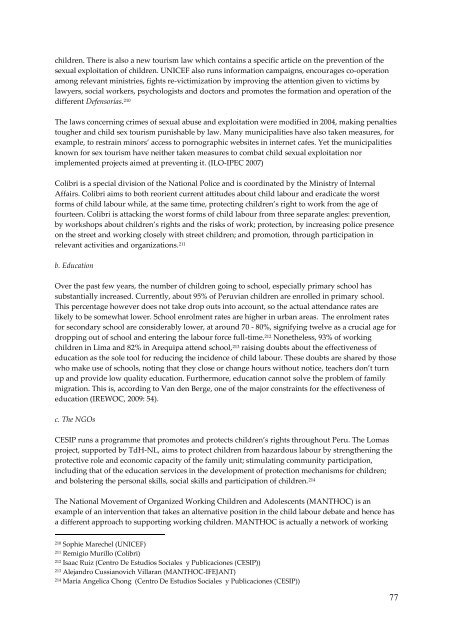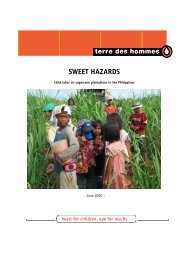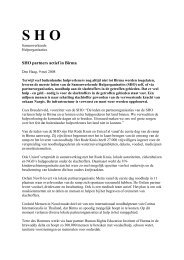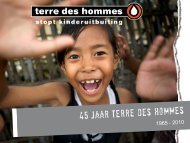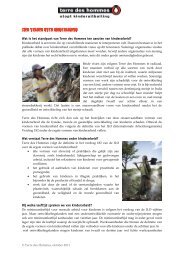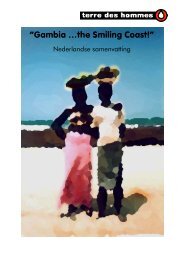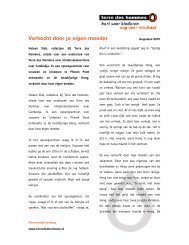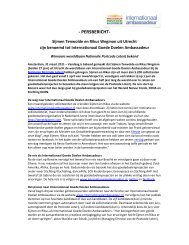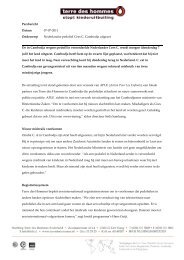Untitled - Terre des Hommes
Untitled - Terre des Hommes
Untitled - Terre des Hommes
- No tags were found...
Create successful ePaper yourself
Turn your PDF publications into a flip-book with our unique Google optimized e-Paper software.
children. There is also a new tourism law which contains a specific article on the prevention of the<br />
sexual exploitation of children. UNICEF also runs information campaigns, encourages co-operation<br />
among relevant ministries, fights re-victimization by improving the attention given to victims by<br />
lawyers, social workers, psychologists and doctors and promotes the formation and operation of the<br />
different Defensorías. 210<br />
The laws concerning crimes of sexual abuse and exploitation were modified in 2004, making penalties<br />
tougher and child sex tourism punishable by law. Many municipalities have also taken measures, for<br />
example, to restrain minors’ access to pornographic websites in internet cafes. Yet the municipalities<br />
known for sex tourism have neither taken measures to combat child sexual exploitation nor<br />
implemented projects aimed at preventing it. (ILO-IPEC 2007)<br />
Colibri is a special division of the National Police and is coordinated by the Ministry of Internal<br />
Affairs. Colibri aims to both reorient current attitu<strong>des</strong> about child labour and eradicate the worst<br />
forms of child labour while, at the same time, protecting children’s right to work from the age of<br />
fourteen. Colibri is attacking the worst forms of child labour from three separate angles: prevention,<br />
by workshops about children’s rights and the risks of work; protection, by increasing police presence<br />
on the street and working closely with street children; and promotion, through participation in<br />
relevant activities and organizations. 211<br />
b. Education<br />
Over the past few years, the number of children going to school, especially primary school has<br />
substantially increased. Currently, about 95% of Peruvian children are enrolled in primary school.<br />
This percentage however does not take drop outs into account, so the actual attendance rates are<br />
likely to be somewhat lower. School enrolment rates are higher in urban areas. The enrolment rates<br />
for secondary school are considerably lower, at around 70 - 80%, signifying twelve as a crucial age for<br />
dropping out of school and entering the labour force full-time. 212 Nonetheless, 93% of working<br />
children in Lima and 82% in Arequipa attend school, 213 raising doubts about the effectiveness of<br />
education as the sole tool for reducing the incidence of child labour. These doubts are shared by those<br />
who make use of schools, noting that they close or change hours without notice, teachers don’t turn<br />
up and provide low quality education. Furthermore, education cannot solve the problem of family<br />
migration. This is, according to Van den Berge, one of the major constraints for the effectiveness of<br />
education (IREWOC, 2009: 54).<br />
c. The NGOs<br />
CESIP runs a programme that promotes and protects children’s rights throughout Peru. The Lomas<br />
project, supported by TdH-NL, aims to protect children from hazardous labour by strengthening the<br />
protective role and economic capacity of the family unit; stimulating community participation,<br />
including that of the education services in the development of protection mechanisms for children;<br />
and bolstering the personal skills, social skills and participation of children. 214<br />
The National Movement of Organized Working Children and Adolescents (MANTHOC) is an<br />
example of an intervention that takes an alternative position in the child labour debate and hence has<br />
a different approach to supporting working children. MANTHOC is actually a network of working<br />
210<br />
Sophie Marechel (UNICEF)<br />
211<br />
Remigio Murillo (Colibri)<br />
212<br />
Isaac Ruiz (Centro De Estudios Sociales y Publicaciones (CESIP))<br />
213<br />
Alejandro Cussianovich Villaran (MANTHOC-IFEJANT)<br />
214<br />
Maria Angelica Chong (Centro De Estudios Sociales y Publicaciones (CESIP))<br />
77


